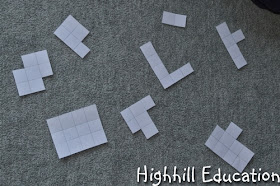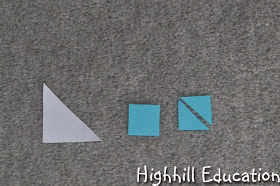Day 7: Area - Squares, Rectangles, and Triangles
Measuring area answers the question how big is it. Formulas used to calculate area and perimeter were introduced to my son when he was exploring math on Khan Academy. Unfortunately, he didn't really understand what area and perimeter were, so he came away thoroughly confused.
Area is measured in squares. After learning about one square inch, he was easily able to determine the area of these shapes built from squares, simply by counting.
Next he determined the number of tiles we would need to redo our bathroom floor in one foot square tiles.
Then we explored triangles. On the right side of the picture below, there is a one inch string, a one square inch piece of paper, a one-half square inch of paper cut into a rectangle, and a one-half square inch of paper cut into a triangle. The middle column contains the same figures, but double the size.
After creating these figures, I asked the kids how big they were.
I asked them how big this two square inch triangle was and they were stumped. So I created a blue triangle the same size and cut it.
They quickly determined it was two square inches.
So they were given the large triangle and asked how big it was.
At first, they both wanted to measure the hypotenuse, but then both decided to draw lines on their triangles.
With different sets of lines they both arrived at the same answer.
This method of discovery mathematics is very important for my son. He learns best when he figures something out for himself. He is a natural problem solver who does not learn well with explanation and example.










I was looking at area of rectangles and squares with my 9yr old son today (using Zaccaro's Challenge Math). He normally catches onto concepts very quickly but sometimes a topic comes along that surprises me. Area was one of those and I made a note to print out some grid paper for him to play with next time. So thanks for this - now I can extend the exploration to cover triangles!
ReplyDelete